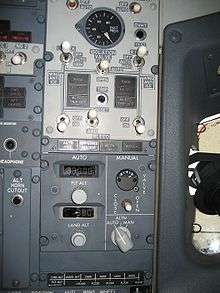Fume event

A fume event occurs when bleed air used for cabin pressurization and air conditioning in a pressurized aircraft is contaminated by chemicals such as engine oil, hydraulic fluid, anti-icing fluid and other potentially hazardous chemicals including cargo spills.[1] Turbine engine oil is an irritant and contains neurotoxic chemicals such as tricresyl phosphate. However, no conclusive evidence exists that engine oil contains sufficient quantities of such chemicals to cause long term damage.[2] Hydraulic fluid is extremely irritating, particularly to the eyes, which creates a hazard to pilots during a fume event. However, it is non-toxic and does not cause lasting damage.[3] Anti-icing fluid has a strong smell, but is not very irritating or toxic.
How cabin pressurization works
Because airliners fly at very high altitudes, the cabin must be pressurized to provide a minimum safe quantity of breathable oxygen to passengers and crew. The cabin is pressurized with bleed air tapped off of the compressor stages, which are prior to the combustion sections, of the jet engines. That air is very hot and must be cooled by heat exchangers, before it is directed into the airconditioning units, which cool it even further.[4]
Handling of fume events
In the event of fumes or smoke in an aircraft, the crew will wear oxygen masks in order to avoid breathing in irritating fumes. Goggles are also available if necessary. If the fumes do not subside after an attempt is made to diagnose and fix the problem, the flight is then diverted to a nearby airport. In a severe fume or smoke event, the flight may descend to an altitude of 10,000 feet (3,000 m) or less where it can safely be depressurized[5]
Health effects
The potential long term health effects of fume events are currently disputed. Most aviation and medical professionals do not believe any long-term health effects exist from fume events, and no studies have shown any danger to the public. However, some consumer and aircrew advocacy groups claim that it can cause a medically unrecognized condition they refer to as aerotoxic syndrome, with symptoms such as fatigue, nausea and possibly premature death.[2][6]
References
- ↑ "UK Committee on Toxicology Leaflet". Retrieved December 31, 2012.
- 1 2 Nassauer, Sarah (July 30, 2009). "Up in the Air: New Worries About 'Fume Events' on Planes". Wall Street Journal. Retrieved December 31, 2012.
- ↑ "Skydrol FAQ". Skydrol. Retrieved December 31, 2012.
- ↑ "Commercial Cabin Air Systems". Boeing. Retrieved October 21, 2014.
- ↑ Voorback, Nico. "Cabin Air Contamination- A Safety Issue" (PDF). European Cockpit Association. Retrieved December 31, 2012.
- ↑ "Aerotoxic.org". Retrieved December 31, 2012.